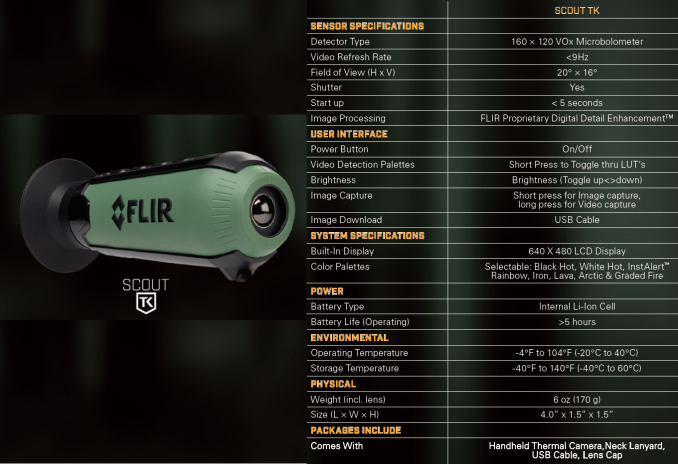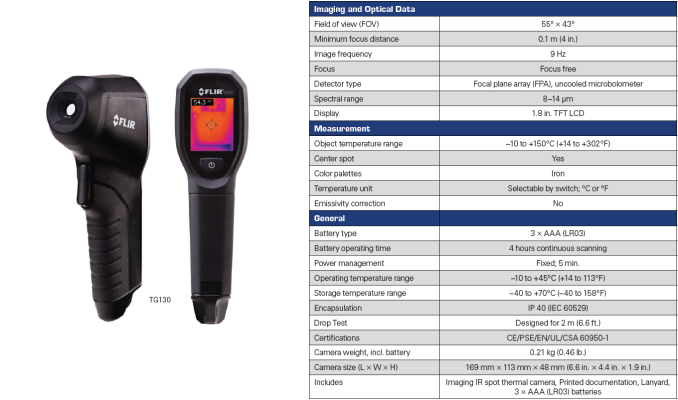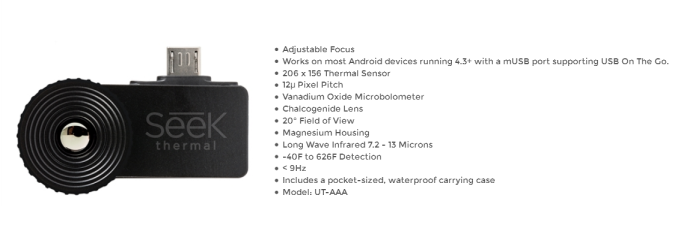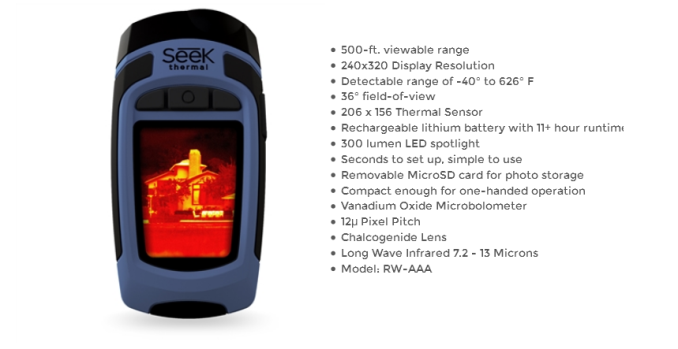Thermal Imaging at CES - FLIR and Seek Thermal
by Ganesh T S on January 25, 2016 8:00 AM EST- Posted in
- Trade Shows
- Thermal Imaging
- Seek Thermal
- CES 2016
- FLIR

Thermal imaging has become more accessible to the average consumer, thanks to advances in the development of low-cost infrared sensors / microbolometers. FLIR was one of the first to make a breakthrough in this segment with the development of the low-cost Lepton sensor (80x60) that was used in the first-generation FLIR One Thermal Imager for iPhone 5/5s. In the meanwhile, Seek Thermal, a startup, debuted their low-cost microbolometer (206x156) in the Seek Thermal Infrared Camera.
In 2015, FLIR continued to make advancements in the sensor space with the launch of the Lepton 3, a 160x120 microbolometer. This sensor was used in the second-generation FLIR One cameras (including the Android version that we have been using in our reviews of mini-PCs). Seek Thermal, on the other hand, had entered the market with a higher resolution sensor. So, their focus has been on developing new products to widen the appeal / addressable market for that sensor. At CES 2016, FLIR demonstrated a couple of new products based on the Lepton sensors, while Seek Thermal showed the products introduced through the course of 2015.
FLIR
The FLIR Scout TK is a stand-alone and rugged thermal camera with specifications similar to the FLIR ONE (i.e, the same 160x120 Lepton 3 sensor), but, meant for outdoor use. It comes with storage for photos and videos, and they can be transferred to a computer for further review. The FoV is narrow, meant more for viewing objects / animals up to 90m away. There is a 640x480 LCD display on one end, and the industrial design allows for one handed operation. The intended use-case is outdoor enthusiasts who want to spot wildlife in the night or in low light situations, as well as those interested in personal and home security. The product uses an internal Li-ion battery that is rechargeable. It can support up to 5 hours of continuous operation with a fully charged battery.
The TG130, a entry-level spot thermal camera for home and small businesses. It is based on the first-generation Lepton core (80x60 sensor). It is targeted at home users who want to find out insulation issues (places of heat loss in a house). It can also help in determining correctness of HVAC operation, electrical equipment troubleshooting, and refrigerator maintenance. There is no storage media to record to, as the usage involves pointing and clicking to freeze the image with the temperature being part of the OSD. The product uses 3xAAA batteries. It can support up to 4 hours of continuous operation with one set of fully charged batteries.
At the FLIR booth, we had the chance to see working models of both the Scout TK as well as the TG130 along with a host of other thermal imagers from FLIR targeting the professional market. The Scout TK and TG130 are both slated to ship later this quarter.
The Scout TK will be priced at $599, while the TG130 will be priced more economically at $249 due to the use of the first-generation Lepton sensor and lack of any recording capabilities.
Seek Thermal
Seek Thermal was showing off the camera models introduced over the course of 2015 at CES. These included the Compact and Compact XR thermal imaging cameras. The Compact is suited for indoor analysis while the Compact XR is suitable for outdoor use. They are both available in iOS and Android versions. The main difference between the first-generation Seek Thermal Infrared camera that we reviewed and the Seek Thermal Compact / Compact XR is the availability of zooming capabilities for better focus on the area of interest in the latter. The availability of the 'optical' zooming feature enables the Compact to have a range of 300m and the Compact XR to have a range of 550m (compared to the 90m range of the equivalent FLIR cameras). The Compact (indoor use) has a 36 degree FoV, while the Compact XR (outdoor use) has a 20 degree FoV.
Seek Compact
Seek CompactXR
In addition, Seek Thermal also demonstrated the Seek Reveal, which is very similar to the FLIR TG130 in terms of use-cases. The added capabilities include a 300 lm. integrated LED flashlight, ruggedness and the ability to withstand submergence in water. The LCD display has a 240x320 resolution. A micro-USB cable can be used to transfer recorded images. The device has a range of around 150m and has a 36 degree FoV similar to the Compact. All of the Seek Thermal offerings are still based on the original 206x156 thermal sensor. While the Compact and CompactXR retail for $249 and $299 respectively, the Reveal, with its in-built display and smartphone-free operation, retails for $399.
Seek Reveal
Concluding Remarks
The offerings from FLIR and Seek Thermal have given consumers a wide range of thermal imaging products to choose from, depending on the intended use-case. We would like to see FLIR improve their Android app for better compatibility with a wider range of mobile devices. Hopefully, a future update to the Lepton series would help them achieve resolution-parity with the Seek Thermal sensor. That said, FLIR's MSX (one of the proprietary features of some of FLIR's cameras that blends the output of an image sensor and the output of the thermal sensor) seems to make up for the disappointing thermal sensor resolution to some extent. On the other side, we would like to see if Seek Thermal can bring in thermal sensors with better resolution at similar price points. On a common note, government restrictions still prevent thermal imagers from offering greater than 9 FPS for videos without going through extensive paperwork. Hopefully, the advent of low-cost thermal imagers like the ones from FLIR and Seek Thermal can help in making this situation better.



















17 Comments
View All Comments
edzieba - Monday, January 25, 2016 - link
It is a shame that a pair of what are effectively IR USB webcams are locked to use with smartphones, rather than being accessible on a PC. They would make a great addition to the Machine vision repertoire.ganeshts - Monday, January 25, 2016 - link
FWIW, FLIR has a SDK available for the FLIR One. It is ostensibly meant for developing Android / iOS apps, but it is possible that one might be able to utilize it in some way when connected to a PC also (my conjecture, after playing around a bit with the SDK)Stuka87 - Monday, January 25, 2016 - link
There are models out there for a PC, if you want to have a camera locked to be used in one physical location. The phone models are just extremely handy, easy to move around, record video, take photos, etc.Madpacket - Monday, January 25, 2016 - link
9 FPS is a little disappointing. Someone needs to buy one of these and mod it to capture at 60 FPS. Think of night vision and attaching one of these to a quad copter to spot any warm blooded thing around you. I can see this market taking off.MrTeal - Monday, January 25, 2016 - link
These don't use CMOS or CCD sensors like a typical webcam. They use a microbolometer, and those generally aren't used for high speed imaging. The 9FPS limit is almost certainly a sensor limit rather than an electronics or interface limit.ganeshts - Monday, January 25, 2016 - link
While I agree they are not like the typical image sensors, the 9 FPS limitation is imposed by the government's export restrictions.I actually talked to FLIR at CES about this - they indicated that if the customer were to get the necessary clearance / paperwork processed, they can enable higher frame rates for the video from the Lepton sensors.
MrTeal - Monday, January 25, 2016 - link
That's interesting. I wonder what the sensor limit on these cheap ones would be. We recently picked up a very nice GigE a-Si imager, and even it is limited to 30FPS at the top end.extide - Monday, January 25, 2016 - link
It's a government export restriction. Probably to make it harder to build guided missiles and the like.name99 - Monday, January 25, 2016 - link
I have one of the original FLIR cameras (the one's hardwired for an iPhone5). I'd say- it's definitely useful/interesting/fun if you buy it at a low price. I would say I recovered its value almost immediately in that I used it to look around my (freezing!) bedroom, confirmed where the coldest areas were, and did something about it by mounting some hooks and hanging some heavy fabric over the areas (the window [flimsy curtains], and the entrance to the bathroom) to ramp up the thermal resistance.
Now, in theory, the camera was not NECESSARY for this. If held at gunpoint, I'd have guessed that those were the two cold spots. But seeing your guesses actually confirmed gives you some extra impetus to get off your butt and try to fix the problem.
- OK, the flip side is the following: These things do not (yet?) give you Predator heat vision, and you can't really convert them into fantastic night vision goggles.
What you have to remember is that with IR you are seeing by emitted, not reflected, light; so that's the first issue. People and other non-stove/car engine things just aren't emitting that many photons (compared to the number of photons being emitted then reflected in vision). So the first thing you need is a large collecting area to collect lots of photons, and something like FLIR is not designed for that task; large collection area is not part of the spec.
The second problem is that the world is full of other stuff ALSO emitting IR. Walking down the street houses, cars, trees, are all emitting IR, and things get lost in that clutter. It's not like seeing a lantern against a black background, but like seeing a lantern against a very busy white to slightly grey background. If you CAN get a person against a cold background, they obviously stand out --- I did manage to see a person on the far side of a bridge, with the cold sky as background, and they were obviously visible from say 50 ft away. But it's going to depend a lot on the background temperature of where you are. A woody environment in summer may be hopeless; the desert in winter may work really well.
So these cameras are good for the things they claim to be good for --- looking around the house for temperature differentials. But when trying to explore the wider world with them, while interesting, you very soon see the limitations to the tech. I suspect real night-vision goggles, in addition to a much larger collection area, are applying a bunch of image processing techniques to accentuate very small differences in temperature, and to edges. Of course in theory you could try to do that with custom SW using these devices, but that's not what they're optimized for. (eg the edge detection the FLIR gives, by imposing optically visible edges on top of the IR image, while it works REALLY WELL for my sort of "what's hot and what's cold in my house?" problem, is not useful if you're trying to engage in night vision.
R3ds - Tuesday, January 26, 2016 - link
I think you may be mixing up light amplification (night vision) with infrared (thermal).